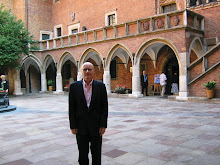O Babylon
In a short “arts, briefly” item that appeared in the January 8, 2009 New York Times, we’ve learned that Babylon may be coming back to life, perhaps as a walk through museum. Of course news about any other place on the planet is of much more newsworthy notice, but if you’ve ever admired rocks in the Middle East, as I have, then this news is of great international consequence. Some who are more familiar with the daily news of four millennia from this locus of the world may say it’s about time, while others may see Babylon as just another bygone of the Ancient World.
But take notice, the U.S. State Department has agreed to funnel $700,000 towards the renovation of this spectacular city, and perhaps this is good news as the Occupation Forces of the 1st Marine Expeditionary Force caused considerable damage to the ancient ruins. Perhaps all of us should chip in one American dollar to the World Monuments Fund so this extraordinary city of the 2nd Millennium B.C.E. can be brought back to its important nexus to world history.
After all, it was the “gateway of the god[s],” perhaps as significant as The Bodhi Tree, or Mount Olympus, or Mount Sinai or Mount Moriah or any other site that reminds us of what the ancient world considered holy and magnificent. Of course it’s also a confusing place, causing much consternation among the peoples of the world, just as much as it did for the characters in the recent global screenplay, “Babel.”
We should give some credit to the city planners, for Babylon at one time was the city of the World, the largest city of the World, but then I’m sure ancient cities of the Far East and Africa had equivalent marvels which we should address sometime soon. While many scholars of the Bible will say the Torah, or for Christian readers, the Old Testament, is sui generis, it is noteworthy that much of the literature that came out of Babylonia found its way, indirectly and subtlety into the Book of Genesis and possibly even Exodus, with reference to the Code of Hammurabi, perhaps the first legal code of the Ancient World. Of course the Code isn’t at the site right now, but neither is anything else.
If it wasn’t for Lord Byron, or Sennacherib, we wouldn’t have such great poetry, or misguided battle tactics in the failed storming of Jerusalem when “The Assyrian came down like the wolf on the fold/And his cohorts were gleaming in purple and gold.” Anyone who knows the story knows that Jerusalem was saved momentarily, in part, connected to the {un-}glory of Babylon.
By the early 600’s (of the B.C.E.’s) the green thumb Nebuchadnezzar II provided for one of the wonders of the world, the nectarian Hanging Gardens, but of course, that’s a story that hasn’t been completely verified. Yet if it wasn’t for Nebuchadnezzar, we might never had heard the unbelievable arias of Giuseppe Verdi’s “Nabucco,” which connects more and more of us to the stony palaces, though few of us want to remember the origin of the opera and Israel’s defeat and exile as is so movingly depicted in Act III with the Chorus of “va pensiero.”
And where would a few of us be today had it not been for the magnanimity of Cyrus the Great who sent the Israelites packing back to Jerusalem after their 1st Exile as noted in Isaiah and Jeremiah? Many of the Jewish holidays, as well as counting any of the days of the week, or months, or years, can possibly be found in the long 70+ year exile in Mesopotamia. Perhaps we need to ask a scholar to take us through parts of The Babylonian Talmud, or even the origins of Genesis and Eden which would take us back to The Enuma Elish and the Babylonian story tellers who were just trying to figure out those very first days in the desert.
For a look at Babylon from Hollywood, get out your DVD copy of Oliver Stone’s “Alexander” and watch the famed warrior/globe trotter enter the magnificent gates of Babylon, as well as seeing all the beauty that it was in the 3rd century before the C.E.
Yet who doesn’t remember the Deutsche Orientgesellschaft and the German team that began excavations in the late 19th Century? But perhaps the oddest of all inscriptions, in our own era, is by a follower of the great past: “This {partial restoration of Babylon} was built by Saddam Hussein, son of Nebuchadnezzar, to glorify Iraq.”
Of course there are other sites to get excited about, and The World Monuments Fund is certainly a place to learn about the many different restoration projects going on in this world, in our own time, but if you’d like to see Babylon brought back to its stony glory, then by all means, see what you have left in your retirement fund, and consider a small donation. Yes of course, the U.S. economy has tanked, or will tank, and how can you give something for heritage, but if you can, then perhaps we can find a way to restore what once was the “gateway of the god(s).”
Monday, January 12, 2009
Subscribe to:
Posts (Atom)

